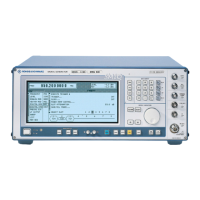Digital Standard IS-95 CDMA SMIQ
1125.5555.03 E-92.130
2.12 Digital Standard IS-95 CDMA
With the options Modulation Coder (SMIQB20), Data Generator (SMIQB11) and option Digital Standard
CDMA (SMIQB42) provided, CDMA signals can be generated according to standard IS-95
1
as well as
J-STD-008.
SMIQ can simulate both the transmit signal of a base station (forward link) and the transmit signal of a
mobile station (reverse link). The forward link signal consists of up to 64 code channels. A reverse link
signal can be generated in the full-rate or half-rate mode.
Simple bit patterns or pseudo random bit sequences (PRBS) can be selected as modulation data for
forward link. Every code channel has a different PRBS. Modulation data are not subject to channel
coding (convolution coding, interleaving).
The following figure shows the schematic of forward link signal generation.
Walsh 0
PN
I
Walsh 1
PN
Q
I
Q
Walsh k
Σ
ΣΣ
Σ
Baseband
FIR Filter
Baseband
FIR Filter
Channel Power Setting
QPSK Mapping
Pattern
PRBS
19200 bps 1.2288 Mcps
Pattern
PRBS
0000...
+
+
+
+
+
+
+
+
+
Fig. 2-76 Forward link signal generation
At a chip rate of 1.2288 Mcps, the modulation data rate for forward link is 19200 bp/s for all channels.
The modulation type is QPSK. For baseband filtering, a FIR filter with equalizer is preset according to
IS-95 (FILTER TYPE IS-95 EQUAL). Other filters can be set as well. The chip rate is preset to
1.2288 Mcps according to IS-95 but can be freely selected.
1
TIA/EIA/IS-95, Mobile Station-Base Station Compatibility Standard for Dual-Mode Wideband Spread Spectrum Cellular
Systems

